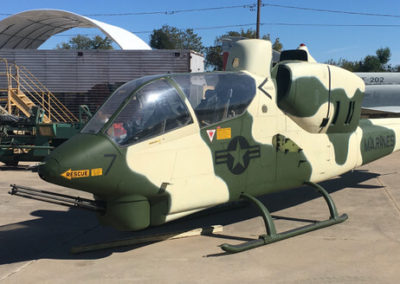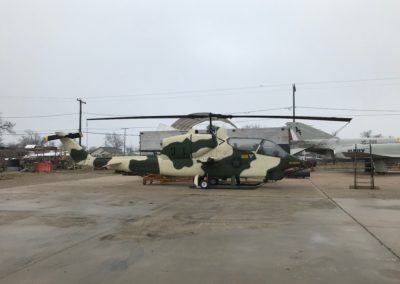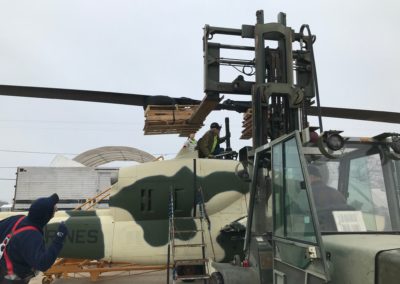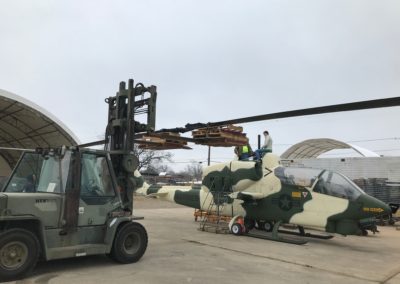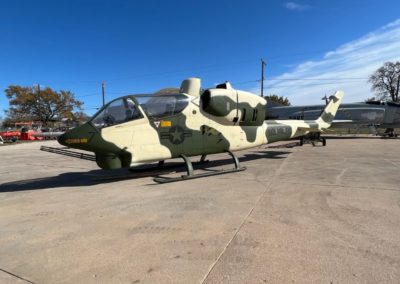AH-1J SeaCobra
With the success of the air assault concept in Vietnam, there became a need for a helicopter gunship to provide armed escort and fire support for lightly armed transport helicopters.
Warbird Overview
With the success of the air assault concept in Vietnam, there became a need for a helicopter gunship to provide armed escort and fire support for lightly armed transport helicopters. The AH-1 Cobra was developed using the rotor, transmission, and engine from the UH-1 “Huey”. The Cobra features tandem seating to give both pilot and gunner nearly unlimited visibility. Both crew stations have flight control and fire control systems permitting flexibility in division of functions under normal and emergency situations.
ABOUT THE AH-1J SEACOBRA
With the success of the air assault concept in Vietnam, there became a need for a helicopter gunship to provide armed escort and fire support for lightly armed transport helicopters. The AH-1 Cobra was developed using the rotor, transmission, and engine from the UH-1 “Huey”. The Cobra features tandem seating to give both pilot and gunner nearly unlimited visibility. Both crew stations have flight control and fire control systems permitting flexibility in division of functions under normal and emergency situations.
The AH-1J SeaCobra was developed for the USMC as a twin engine variant of the single engine Cobra with the desire for improved safety and redundancy for over-water operation. The Pratt & Whitney Twinpac T400 engine (two 900-hp turboshaft engines coupled together) gave an overall increase in performance and reliability. The J model also included a more powerful gun with the three barrel XM197 20mm cannon as well as other improvements.
When Marine and Navy carrier aircraft mined and closed Haiphong Harbor (the North’s main port) in May 1972, the North Vietnamese resorted to having Chinese and Soviet cargo ships anchor offshore at various locations and cargo would be offloaded into smaller sampans for transfer to shore. It was decided that the AH-1J would be ideal for the role of maritime interdiction off the coast of North Vietnam. In June 1972, HMA-369 boarded the amphibious transport ship USS Denver (LPD-9) and headed for waters off North Vietnam. The SeaCobras operated in pairs and would sink the sampans with their Zuni rockets and 20mm cannon. The pilots were also trained to call in naval gunfire and air strikes while the gunners in front seats of the AH-1Js focused on the sampans. After several weeks, the shore-based heavy AAA guns learned not to fire on the SeaCobras thanks to the naval gunfire support and air strikes the pilots would call in.
The major buyers of the AH-1J SeaCobra was the US Marine Corps (), Iran (220), and South Korea (8).
In 1971, Iran purchased 202 improved AH-1J, named “AH-1J International.” This aircraft was hugely effecting in the Iran/Iraq War. Some of these helicopters are still in service.
Fact #1
Bell Helicopter built this in Fort Worth and is one of the earliest twin engine Cobras ever built for the US Marine Corps. Marine Corps Cobras are the longest-serving Forward Air Control aircraft in the US military beginning in 1969 and continuing until today.
Fact #2
This aircraft was used as a maintenance trainer by the Naval Air Maintenance Training Detachment (NAMTRDET) at Marine Corps Air Station Camp Pendleton, California, for many years.
Fact #3
After serving as a training device, it was on display at the National Naval Aviation Museum in Pensacola, Florida for eleven years.
Manufacturer: Bell Helicopter Company
Dimensions: Length: 53 ft., 4 in
Height: 13 ft., 8 in.
Rotor Diameter: 44 ft
Empty Weights: 6,518 lb
Gross Weight: 9,637 lb.
Power Plant: Two 1,800 horsepower Pratt & Whitney T400-CP engines
Performance
Maximum Speed: 207 mph
Service Ceiling: 10,550 ft
Range: 359 miles
Armament
M197 3-barrel Gatling gun
Rockets: 2.75 in. MK40 rockets; 5 in. Zuni rockets
Missiles: AIM-9 Sidewinder air-to-air missiles; Wire-guided TOW antitank missiles
Crew: Pilot and gunner/observer
The early history of this aircraft is unclear. The airframe was an instructional trainer at Camp Pendleton, CA. Prior to that, it may have been a flyable aircraft. That research remains to be done. The tail number (070280) was made up when the aircraft was restored at the the National Naval Aviation Museum and put on display in 1991. The Cobra carries the unique Desert Storm color scheme. The Fort Worth Aviation Museum acquired this AH-1J SeaCobra in 2021. This aircraft is on loan from the National Naval Aviation Museum in Pensacola, FL.
Good shape and will need a good wash and brush down.
Note: Scheduling is always a moving target depending on weather and workload. All schedules are subject to changes.
Become a Member!
FLIGHT SIMULATOR
HOURS
Saturday: 9AM-2PM
Sunday: 11AM-3PM
